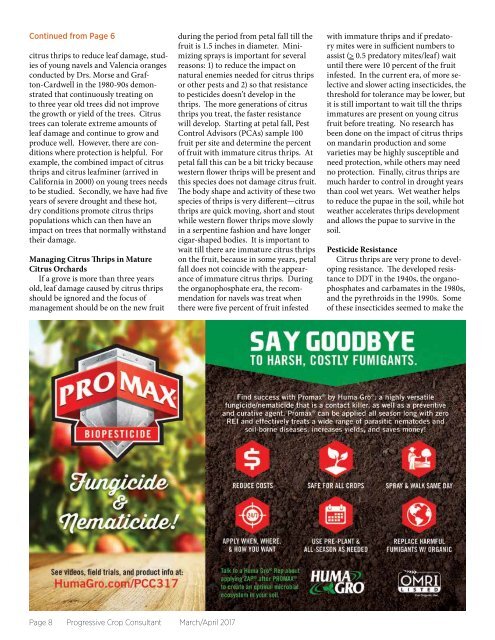Mar_Apr_PCC_2017_Web
You also want an ePaper? Increase the reach of your titles
YUMPU automatically turns print PDFs into web optimized ePapers that Google loves.
Continued from Page 6<br />
citrus thrips to reduce leaf damage, studies<br />
of young navels and Valencia oranges<br />
conducted by Drs. Morse and Grafton-Cardwell<br />
in the 1980-90s demonstrated<br />
that continuously treating on<br />
to three year old trees did not improve<br />
the growth or yield of the trees. Citrus<br />
trees can tolerate extreme amounts of<br />
leaf damage and continue to grow and<br />
produce well. However, there are conditions<br />
where protection is helpful. For<br />
example, the combined impact of citrus<br />
thrips and citrus leafminer (arrived in<br />
California in 2000) on young trees needs<br />
to be studied. Secondly, we have had five<br />
years of severe drought and these hot,<br />
dry conditions promote citrus thrips<br />
populations which can then have an<br />
impact on trees that normally withstand<br />
their damage.<br />
Managing Citrus Thrips in Mature<br />
Citrus Orchards<br />
If a grove is more than three years<br />
old, leaf damage caused by citrus thrips<br />
should be ignored and the focus of<br />
management should be on the new fruit<br />
during the period from petal fall till the<br />
fruit is 1.5 inches in diameter. Minimizing<br />
sprays is important for several<br />
reasons: 1) to reduce the impact on<br />
natural enemies needed for citrus thrips<br />
or other pests and 2) so that resistance<br />
to pesticides doesn’t develop in the<br />
thrips. The more generations of citrus<br />
thrips you treat, the faster resistance<br />
will develop. Starting at petal fall, Pest<br />
Control Advisors (PCAs) sample 100<br />
fruit per site and determine the percent<br />
of fruit with immature citrus thrips. At<br />
petal fall this can be a bit tricky because<br />
western flower thrips will be present and<br />
this species does not damage citrus fruit.<br />
The body shape and activity of these two<br />
species of thrips is very different—citrus<br />
thrips are quick moving, short and stout<br />
while western flower thrips move slowly<br />
in a serpentine fashion and have longer<br />
cigar-shaped bodies. It is important to<br />
wait till there are immature citrus thrips<br />
on the fruit, because in some years, petal<br />
fall does not coincide with the appearance<br />
of immature citrus thrips. During<br />
the organophosphate era, the recommendation<br />
for navels was treat when<br />
there were five percent of fruit infested<br />
with immature thrips and if predatory<br />
mites were in sufficient numbers to<br />
assist (> 0.5 predatory mites/leaf) wait<br />
until there were 10 percent of the fruit<br />
infested. In the current era, of more selective<br />
and slower acting insecticides, the<br />
threshold for tolerance may be lower, but<br />
it is still important to wait till the thrips<br />
immatures are present on young citrus<br />
fruit before treating. No research has<br />
been done on the impact of citrus thrips<br />
on mandarin production and some<br />
varieties may be highly susceptible and<br />
need protection, while others may need<br />
no protection. Finally, citrus thrips are<br />
much harder to control in drought years<br />
than cool wet years. Wet weather helps<br />
to reduce the pupae in the soil, while hot<br />
weather accelerates thrips development<br />
and allows the pupae to survive in the<br />
soil.<br />
Pesticide Resistance<br />
Citrus thrips are very prone to developing<br />
resistance. The developed resistance<br />
to DDT in the 1940s, the organophosphates<br />
and carbamates in the 1980s,<br />
and the pyrethroids in the 1990s. Some<br />
of these insecticides seemed to make the<br />
Page 8 Progressive Crop Consultant <strong>Mar</strong>ch/<strong>Apr</strong>il <strong>2017</strong>


















